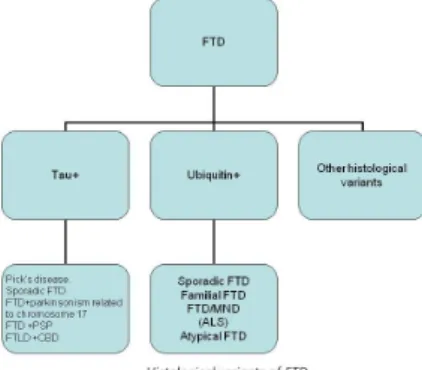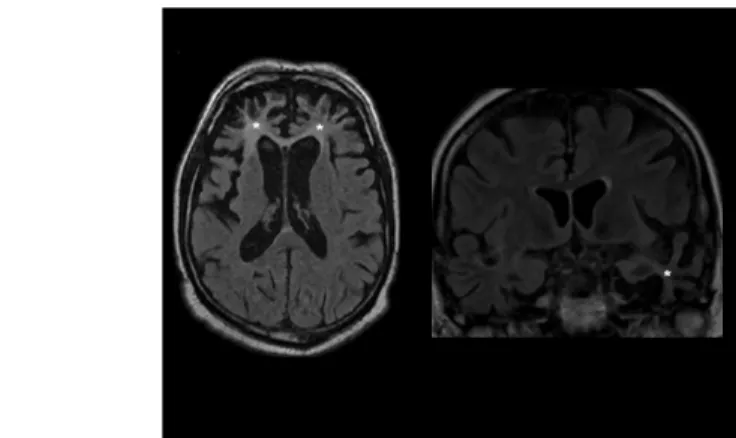III./6.4.: Frontotemporal dementia (FTD)
Other names: Pick-dementia, Pick-disease, Pick-complex, frontotemporal lobar degeneration, etc.
FTD includes a group of neurodegenerative syndromes described in the last 100 years with specific clinical and pathological characteristics.
The followings symptoms are suggestive for this type of dementia: early onset, behavioral disorder, affective symptoms, and executive dysfunction.
Epidemiological data are insufficient, but FTD represents about 10-15 % of all dementias of degenerative origin, and a considerable part of dementia in younger age groups.
Both hereditary and sporadic forms were described.
Male/female ratio: 3/2.
Arnold Pick described in 1892 his first case of progressive aphasia and behavioral changes associated with frontal lobe atrophy (Fig. 11). Pick-bodies (silver stained inclusions) and Pick-cells (ballooned cells) were identified as the histological hallmarks of this disease.
Fig. 11: Severe frontal and mild temporal atrophy in FTD
The clinical and pathological classification is still changing; FTD is a heterogeneous group of certain neurodegenerative disorders. There are two main histopathological forms of FTD: “taupathies” and “ubiquinopathies” (Fig. 12 and 13).
The similar histological and genetic background suggests a common origin of some neurodegenerative disorders with similar symptoms: dementia, parkinsonism, amyotrophy.
Fig. 12: Syndromes belonging to the FTD group Fig. 13: Histological variants of FTD
The slowly developing syndrome of FTD in a 40-60-year-old patient may imitate psychiatric disease, because of the dominant behavioral and affective symptoms similar
to depression or mania. Apathy or moria may be present that may reach even a psychotic level. Some of the patients are disinhibited, while others show rigid thinking.
Perseveration or stereotype activities may be similar to those seen in obsessive compulsive disorder or schizophrenia. The negligence of personal grooming, and the decline of social and ethical behavior are characteristic symptoms. Executive
dysfunction is also characteristic: planning and resolving complex tasks become
impossible. In early phases, speech is characterized by anomia and the use of stereotype phrases, and - in contrast to Alzheimer’s disease - fluency and sentence construction are preserved. Some elements of Klüver-Bucy syndrome may appear in some patients, e.g.
hyperphagia and hypersexuality.
In addition to the signs of dementia, neurological examination may detect signs of parkinsonism, abasia, dysarthria, gaze palsy, myoclonia, dystonia, and in some cases symptoms of motoneuron disease (MND): muscular atrophy and weakness. In FTD, memory and orientation are affected later and to a lesser degree than in AD.
Diagnosis of FTD is difficult because early signs are non-specific. In a patient with no history of psychiatric illness, slowly progressive behavioral and affective changes associated with other frontal signs and aphasia may be suggestive of FTD. During the first years of the disease, MMSE may be normal and more complex neuropsychological tests are required.
Neuroimaging is important in excluding other intracranial conditions causing similar symptoms. A negative result on cranial CT, MRI, SPECT, and PET is compatible with FTD. Later on, the atrophy of the frontal lobes, enlargement of the frontal horns of the ventricles are commonly seen (Fig. 14).
Fig. 14: Severe atrophy of the frontal lobes and the left temporal lobe (marked with stars) in a patient with FTD (MRI, FLAIR images)
Differential diagnosis: Alzheimer’s disease, depression, bipolar affective disorder, schizophrenia, frontal lobe tumors, abscess, encephalitis, trauma, post-stroke syndrome must be excluded.
The survival is approximately 7 years. In the terminal stage of the disease, patients become mute and incontinent, and grasp and sucking reflexes may be present.
Treatment is only symptomatic, there are no drugs with confirmed efficacy in FTD.
Cholinesterase inhibitors may aggravate psychiatric symptoms, causing especially agitation. Neuroleptics with parkinsonian side effects are contraindicated, atypical neuroleptics should be used when necessary. SSRI type antidepressants may be recommended for depressive symptoms. Supportive care is the essential part in patient management after the clinical diagnosis of FTD was established.

